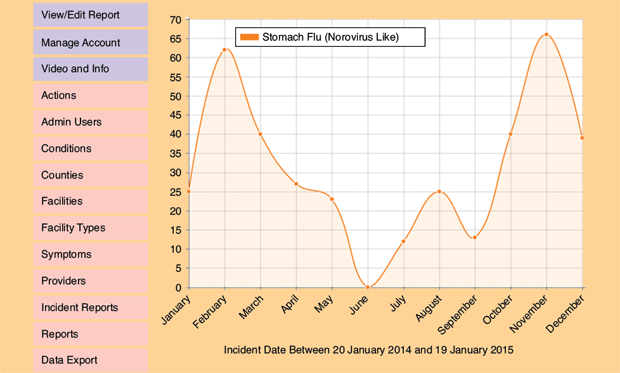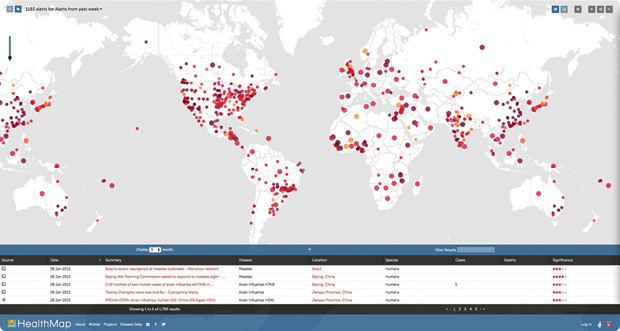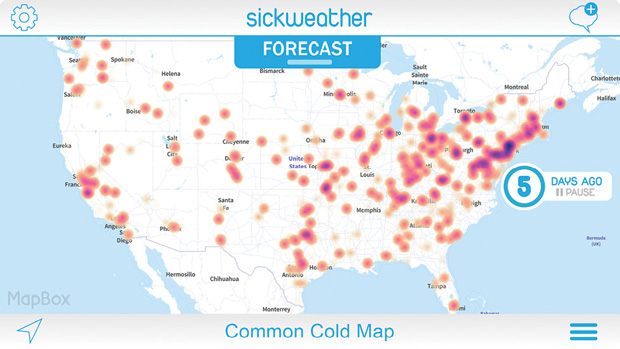Measles. A strange polio-like paralysis. Ebola. In the last year, the spread of infectious disease has become standard fare for the nightly news. As such diseases grab headlines, child-care providers, families, schools, and public health officials are turning to new ways of understanding and coping with the spread of disease.
Online disease tracking systems for public use are emerging as tools to complement traditional biosurveillance, which occurs when health care providers report data to state health officials, who then convey the information to the Centers for Disease Control and Prevention (CDC) in Atlanta. Virtual tracking tools, such as Google Flu Trends and HealthMap, are relatively new but offer the potential to equip the public with quick and contextualized information. Armed with real-time data about epidemics and outbreaks, schools, health officials, and parents may better prepare for, and hopefully minimize, the spread of illness.
“Online tools are still maturing but are proving to be powerful in terms of in terms of tracking diseases,” says James Sejvar, a neuroepidemiologist with the CDC who investigates unusual illnesses, such as the polio-like paralysis that has afflicted at least 100 children in the United States since last fall. “Public-facing tracking tools can help people be aware of where there’s heavy transmission and can serve as a reminder to take the basic actions to minimize risk, like washing hands and staying up-to-date in their vaccines.”
Canaries in the Coal Mine
Andrew Hashikawa, a pediatrician who specializes in emergency medicine at the University of Michigan, Ann Arbor, noticed that many parents visited the emergency department with children who did not appear seriously ill. When he asked why parents urgently needed a consultation, he discovered that they sought a doctor’s note to allow their children back to child care the next day. It turns out that child-care providers are not necessarily equipped with medical training, and, because illness can spread quickly among very young children, many centers send kids home even when they have minor health issues.
Hashikawa worked with local child-care centers to create a password-protected Web site called SickChildCare.org for reporting absences and illness. What began as a small pilot of four centers and 400 preschool children in the fall of 2014 has now expanded to ten centers and 1,600 children in the region and continues to grow. So far, the numbers seem to be fairly accurate, showing near-real-time upticks in cases like the stomach flu or pinkeye.
“Kids in day care get sick much more often than other kids,” says Hashikawa. “Young children are like the canary in the coal mine—they tend to be the first to get ill in a population.”
These children then often pass their illnesses on to the next most vulnerable in the population, the elderly, before the disease moves to other adults. Because children tend to be early indicators of things like the stomach flu and strep throat, many attempts to track transmission have focused on them. However, previous tracking efforts have mainly looked to schools for data, which has limitations—students can miss school for reasons other than illness, and there are gaps in data during the winter and summer holidays.

Aside from offering accurate and timely information, Hashikawa says his system also provides value to child-care centers in the form of shared data and alerts (above). “Biosurveillance has typically been a one-way street—providers send in information but don’t always get access to all of the data,” he says. “I’m hoping to give real-time feedback to child-care providers to arm them with knowledge to prepare for outbreaks.”
Because child-care providers themselves are prone to catch illnesses from children, they can plan to increase staffing when they get an alert about a disease spreading in the community. They can also know when to arrange a full sterilization (bleaching surfaces, for example) of the centers.
“At the end of January, the system picked up 40 cases of stomach flu in one week,” says Hashikawa. “Because the centers can’t do thorough cleaning every day, we sent a message to users suggesting they do a full wipe-down of the centers that weekend. A lot of centers did, potentially preventing the illness from spreading.”
Hashikawa is incorporating an educational component to the system as well—he and his staff have begun to upload short video recommendations of symptoms to look for and actions to take around a particular illness when it starts to spread (below). Next, he plans to expand to the Detroit area, where many child-care providers do not have resources for medical training.

Crowdsourcing Sickness
On average, more than 100 children in the United States die and thousands more are hospitalized during flu season every year, while the added threat of an epidemic looms. To combat this and other illnesses, multiple efforts have been put in place to automatically mine online information to generate public awareness around the spread of disease.
One of the most well-known trackers is Google Flu Trends, which started in partnership with the CDC in 2008 with the aim of providing early flu alerts a week or so before official reports. Researchers found a significant correlation between Google search patterns for flu symptoms and visits to the doctor, suggesting that user searches can be a preemptive sign of disease transmission. However, Google Flu Trends’ predictions have not been as accurate as expected in the last few years, sometimes significantly overestimating the number of flu cases. In October 2014, Google announced a new model for the 2014–2015 flu season. The new model does not just rely on search trends but also incorporates—and strives to learn from—official CDC data on the flu as it is released.

Another Web site called HealthMap, developed by researchers at Boston Children’s Hospital, was launched in 2006. The site aggregates information from a variety of sources—such as the World Health Organization (WHO), online news sources, eyewitness accounts, and official reports—to present an interactive map that lists different disease outbreaks (above). Last year, HealthMap spotted several cases of a “mystery hemorrhagic fever” nine days before the WHO formally announced the Ebola epidemic, indicating the power of faster, crowdsourced, and aggregated online disease tracking to inform both public health officials and the public.
“There are great examples of harnessing massive amounts of online information to provide a new view of public health and successfully detect early outbreaks of influenza, swine flu, or Ebola,” says John Brownstein, cofounder of HealthMap and associate professor of pediatrics at Harvard University’s Center for Biomedical Informatics. “However, there is still work that needs to be done in terms of fine-tuning and minimizing noise, as well as thinking about how best to provide alerts to the public.”
The Web site also offers additional services, such as the HealthMap Vaccine Finder, which charts the locales where a user can get a flu or measles (MMR) shot. In addition, the project has expanded to phone apps that provide real-time sickness surveillance, including Outbreaks Near Me and Flu Near You. “Traditional public health methods for disease tracking still make the most sense, but the idea is we could adopt new tools to provide broader insights into health and disease, both for public health officials and the public,” says Brownstein.
While many online trackers rely on data from search activity or news reports related to the flu, the Maryland-based app Sickweather uses proprietary algorithms to mine about two million reports of illnesses a month exclusively from social media sites to offer location-based, “weather warning”-like alerts to users. And it has had success for its 300,000 monthly active users, according to Graham Dodge, its chief executive officer and cofounder.
“Sickweather has identified flu outbreaks six weeks before the CDC confirmed it, and our advisors from Johns Hopkins University have found very strong correlations between reports of flu on Twitter and CDC’s Influenza-like Illness Surveillance Network (ILINet),” says Dodge. Sickweather currently tracks 23 symptoms and illnesses—including the flu, strep throat, and whooping cough, as well as childhood illnesses such as pinkeye and croup—and the company plans to double that number this year (below).

One app user, a mother whose son developed a mild fever, told Sickweather that she typically would have waited to see what other symptoms emerged before taking him to the doctor. But she had just received a strep throat alert from the app, so she took her son in for a throat culture and found that he did have strep. Had the mother not received the disease-specific alert tied to her location, her son would likely have gotten sicker and possibly infected other students, says Dodge.
Even for tracking apps that are able to quickly and accurately show disease transmission, there are limitations. Because public online tracking systems typically do not gather extensive information around cases, they cannot reliably identify strains of viruses. They must also take into account how to carry out quality control and create useful, relevant context for users.
“Digital disease surveillance is not meant to replace traditional methods of public health reporting, but it can help understand real-time trends for early detection,” says Dodge. “This can ultimately then help stall or stop the spread of illness by enabling people to make better health decisions when illnesses are on the rise in their areas.”



